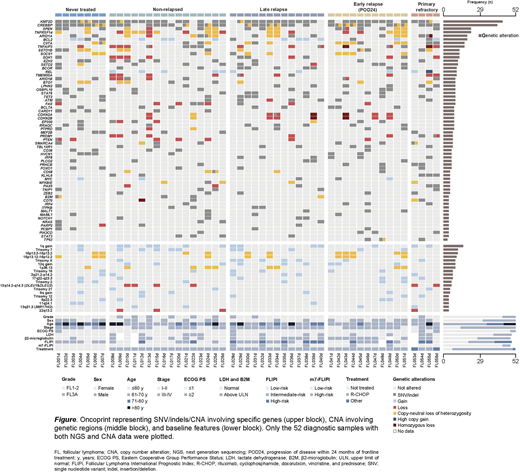Introduction
Outcomes for follicular lymphoma (FL) patients are generally good. Clinical and biological variables have been studied to identify patients at higher risk of early relapse, which markedly impacts survival. However, the genetic landscape of FL according to its clinical behavior (need of treatment and timing of relapse) is not well characterized, which was the aim of the present study.
Patients and Methods
We included 67 samples from 55 grade 1-3A FL patients from a single institution [55 samples at diagnosis (D), and 12 at relapse (R)]. Five groups were defined according to their clinical behavior: never required treatment after >5 years (y) of follow-up [never treated (NT), n=7]; treated and did not relapse after >9 y of follow-up, [non-relapsed (NR), n=19]; treated and relapsed beyond 24 months of frontline therapy [late relapse (LR), n=14]; treated and relapsed within 24 months of frontline treatment [early relapse (ER), n=11]; and primary refractory (PR, n=4). Of the 48 treated patients, 96% received R-CHOP. Patients developing histologic transformation were not included.
DNA was extracted from FFPE tissue biopsies. Copy number alterations (CNA) were assessed in 50 D and 11 R samples [OncoScan CNV Assay (Thermofisher)], and single nucleotide variants (SNV) and insertions/deletions (indels) in 51 D and 10 R samples using a B-cell malignancy NGS panel examining 121 genes (SureSelectXT, Agilent Technologies). Genes and genomic regions were considered altered if they harbored SNV/indels and/or CNA. For comparisons and plotting, only the 52 D samples with both NGS and CNA data were considered. Non-parametric statistical tests were used.
Results
Median age was 56 y (range, 26−79), and 30 patients (55%) were female. Forty-two patients (76%) had stage III-IV disease, without significant differences among groups. Thirteen patients (25%) had a high-risk FLIPI score, a percentage that was higher in the LR and PR groups (50 and 67%, respectively, P=0.02). With a median follow-up of 12.9 y, 10-y overall survival estimates were 71, 100, 74, 82, and 0% for NT, NR, LR, ER, and PR patients, respectively.
We detected CNA in all samples, with a median number of 7 (range, 1−27) for D samples, and of 6 (2−19) for R samples. We also identified SNV/indels in all samples, with a median number of 10 (1−23) for D samples, and of 9 (3−18) for R samples.
The most commonly altered genes at diagnosis were KMT2D (82%), CREBBP (73%), SPEN (38%), TNFRSF14 (38%), ARID1A (33%), and BCL2 (33%) (Figure). There were no significant differences in the number of altered genes/regions among the five groups.
Genes or regions with significantly different alteration frequency among groups were: CARD11 (57, 12, 0, 9, and 0% for NT, NR, LR, ER, and PR, respectively, P=0.014), CD70 (12% for NR, 50% for PR, and 0 for the remaining groups P=0.026), HIST1H1B (29% for NT, and 0% for the remaining groups, P=0.020), HVCN1 (43, 6, 0, 18, and 0% for NT, NR, LR, ER, and PR, respectively, P=0.048), KLHL6 (12% for NR, 75% for PR, and 0 for the remaining groups, P=0.002), PRKCB (0, 6, 0, 18, 50%, P=0.037), and 13q14.2-q14.3 loss (DLEU1/DLEU2) (24% for NR, 50% for PR, and 0 for the remaining groups, P=0.015).
Two genes had a significantly lower alteration rate comparing the cases with a favorable (NT, NR, LR) and more aggressive (ER, PR) clinical behavior: CIITA (22 vs. 53%, P=0.043), and PRKCB (3 vs. 27%, P=0.044).
Of the 51 patients for which the m7-FLIPI was calculated, six (12%) had a high-risk score. Of note, none of the high-risk patients belonged to the NT or NR groups.
No significant differences were found in the number of altered genes/regions between D and R, or in the alteration frequency of each gene/region. We identified the presence of an ancestral common precursor cell with a divergent evolution in all paired cases. The median percentage of shared alterations between D and R was 50% (range 28−63%).
Conclusions
In this comprehensive genetic analysis of 55 FL patients, categorized into five groups according to their clinical behavior, alterations in the chromatin modifying genes KMT2D and CREBBP were the most frequent, and CIITA and PRKCB were more frequently altered in cases with a shorter duration of response. These data warrant further study of the mechanisms underlying these mutations, mutual exclusivity/co-occurrence, and relationships with B-cell biology and the tumor microenvironment.
Nadeu:Janssen: Honoraria. Giné:Gilead: Research Funding; Janssen: Research Funding; Roche: Research Funding. Armando:Janssen: Research Funding; Roche: Consultancy, Research Funding; Gilead: Consultancy, Research Funding; Celgene: Consultancy, Research Funding.
Author notes
Asterisk with author names denotes non-ASH members.


This feature is available to Subscribers Only
Sign In or Create an Account Close Modal